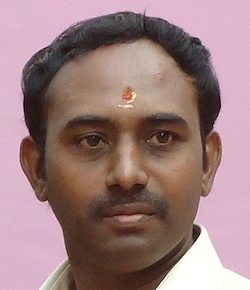V. P. Sampath is a man of few words (as proven by his short replies to my questions) but possesses in-depth knowledge of FPGA, chip design and team management. What sets him apart is that he likes to share his knowledge through blogs, industry seminars, and writing articles for publications like Electronics For You. How does he do all this? What motivates him? How did he become what he's today? And most importantly—how can others follow the same path? I interacted with him to understand his professional journey, and try and uncover answers to some of these questions…
Q. Can you describe your current role?

V.P.Sampath Senior Member, IEEE M.I.E–Technical Architect, Adeptchips Pvt Ltd, Bangalore
A. I am the Technical Architect at Adept Chips Pvt Limited, Bangalore. My primary responsibility is to design drive and manage all projects within deadlines. I manage a team of engineers, whom I mentor towards developing expertise at their work in accordance with current industry standards. I also participate in debate sessions and presentations by both FPGA and Embedded teams and to involve in knowledge sharing by blogging and posting frequent emails to my team which I consider my favourite methods to keep us updated on latest trends.
Q. What are the primary results that you are expected to achieve for your organization in this role?
A. Timely delivery of the project to the end customer. Updating technical knowledge of myself and my team members with respect to market demands. Implementing technology to enable a more mobile workforce, re-engineering
Q. What are the things that excite you–about this role?
A. Team building, learning new things in a team, meeting project goals, deadlines through organizational abilities, securing or building business, handling challenging projects where I can apply my skills, developing innovative ideas that come to fruition, streamlining projects and saving the company money
Q. What're the top 2 or 3 challenges for you in this role?
A. Working on complex projects with tight deadlines. Team management. My personal time management.
Q. What are the skill sets needed to reach this role?
A. In addition looking the hardware and embedded teams to define design requirements, architecting solutions to meet those requirements, providing technical leadership to the team members during implementation, holding design/code reviews and driving continuous process improvements for increased productivity. An excellent team player and a leader. A can-do attitude to deliver quality results on time.
Q. Is this the kind of role that you had dreamt of when you were in college?
A. Yes, of course. In addition, I also dreamt of being the CEO of the company. In the college, I initiated a start-up company by the name Pitrodo Communications.
Q. What happened to this start-up?
A. The start-up didn't materialize due to lack of funding.
Q. For youngsters dreaming to fill in your shoes—what would be your advice to them?
A. There are a lot of career opportunities in the field of chip design including roles in design, verification, synthesis of FPGAs and ASICs, physical design, layout and in mixed signal. In addition, jobs are there in board design and in embedded hardware as well as embedded software.
Q. What aspects should they work on to reach here?
A. My suggestion is that students in electronics (circuit) branches should have a strong knowledge in digital logic design, CMOS design, microprocessor & micro-controller design, C programming and Verilog programming. For the computer science students, basics of digital logic design and C programming can help them develop a career related to EDA tools. Protocol knowledge in I2C, SPI and UART is added advantage.
For candidates who want to go into the professions related to embedded systems, they should be very strong in C and data structures in Linux environment/platform. C++ programming is an added advantage. A. They should know some architecture level knowledge like ARM, x86, MIPS and PPC architectures and should be exposed to protocol knowledge in I2C, SPI, UART, TCP/IP and UDP.
Q. What are the key mistakes that you made that you think you should have avoided in hindsight?
A. Holding on to an under-performing employee for a long time. Spending more time and money than you think you will need
Q. Any tips on how to learn and grow?
A. Learn from peers, learn from mistakes, keeping upgrading your personal benchmarks.
Q. Any good leaders that you worked for?
A. I worked for an onsite where I worked with Anindya Chakrabharthi, CTO of Telesoft Neutek. Former CTO of Tata Communications, Mumbai.
Q. What did you learn from them?
A. Work smartly.
Q. Can you define this "work smartly" for the benefit of our readers?
The post There are a Lot of Career Opportunities in the Field of Chip Design appeared first on Electronics For You.
No hay comentarios:
Publicar un comentario